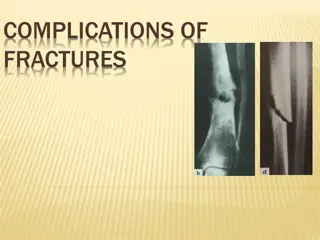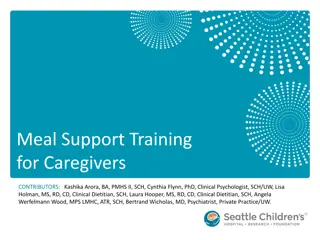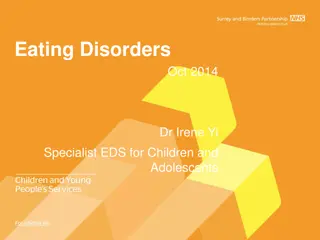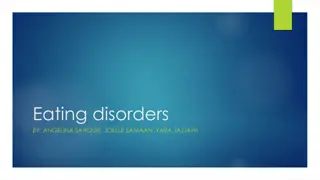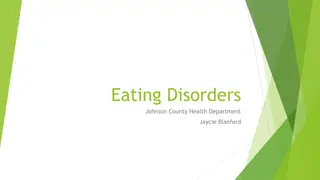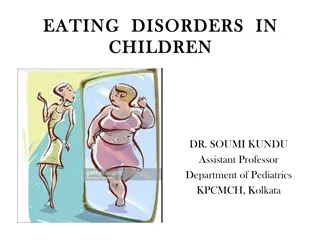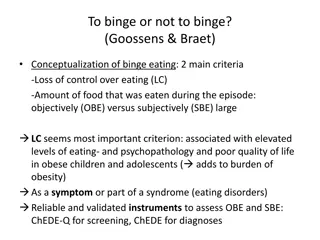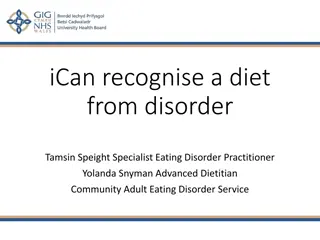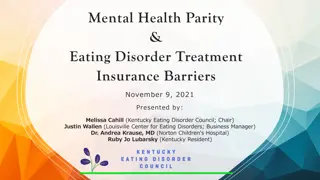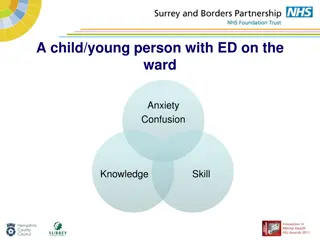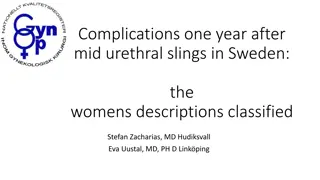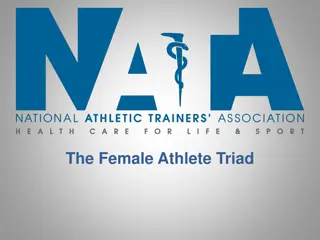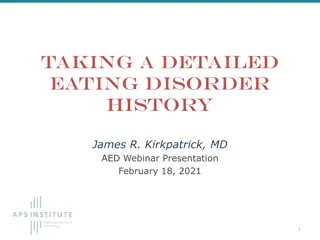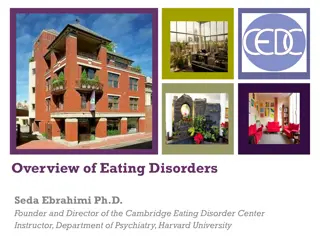Understanding Eating Disorders: Medical Complications and Treatment
This presentation by Dr. Maria C. Monge covers the common eating disorders in teenage patients, potential medical complications, and the role of the medical team in treatment. It includes definitions of disorders like Anorexia Nervosa, Bulimia Nervosa, and Binge Eating Disorder according to DSM-5 criteria. Anorexia nervosa has the highest mortality rate among mental health disorders. The session aims to enhance awareness and knowledge in managing eating disorders among adolescents.
Download Presentation

Please find below an Image/Link to download the presentation.
The content on the website is provided AS IS for your information and personal use only. It may not be sold, licensed, or shared on other websites without obtaining consent from the author. Download presentation by click this link. If you encounter any issues during the download, it is possible that the publisher has removed the file from their server.
E N D
Presentation Transcript
Eating Disorders Medical Complications and their treatment Maria C. Monge, MD, MAT Assistant Professor of Medicine, Dell Medical School, University of Texas at Austin Director of Adolescent Medicine UT-Austin Pediatrics Residency Program
Disclosures I have no relevant financial disclosures.
Objectives 1. Describe the most common eating disorders in teenage patients. 2. Identify potential medical complications of common eating disorders. 3. Recognize the role of the medical team in treating teenage patients with eating disorders
DSM-5: Anorexia Nervosa Restrictive food intake leading to significant low body weight Intense fear of gaining weight or becoming fat OR Persistent behavior that interferes with weight gain, even though at a significantly low weight. Disturbance in the way in which one s body weight or shape is experienced, undue influence of body weight or shape on self-evaluation, or denial of the seriousness of the current low body weight Removed in DSM-5: Amenorrhea, weight <85%MBW
Did you know? Anorexia nervosa has the highest mortality rate of all mental health disorders.
DSM-5: Atypical Anorexia All criteria for AN Weight in normal range
DSM-5: Bulimia Nervosa Recurrent episodes of binge eating out of control within 2 hour period, more than average person would eat in similar time THEN Recurrent inappropriate compensatory behaviors to prevent weight gain Vomiting, laxatives, diuretics, enemas, fasting, excessive exercise At least 1x/week for 3 months Self-evaluation is unduly influenced by body shape and weight.
DSM-5 Binge Eating Disorder Recurrent episodes of bingeing Eating significantly more food in a short period of time (2h max) than most people would eat under similar circumstances At least 1x/week x 3 months Marked by feelings of lack of control Significant distress over pattern 3 or more of the following Eating much more rapidly than normal Eating until feeling uncomfortably full Eating large amounts of food when not feeling hungry Eating alone because of feeling embarrassed by how much one is eating Feeling disgusted with oneself, depressed or very guilty afterward
DSM-5: Avoidant/Restrictive Food Intake Disorder (ARFID) Lack of interest in food or concern about adverse consequences of eating Results in significant weight loss and nutritional deficiency which cannot be attributed to another cause No weight or body shape concerns
We are worried. Ed is a 15 year old male who is brought to emergency room by his mother concerned about his weight and mood. Decreased intake over the past 3 months Going to the gym more often Losing weight Prior medical history Generally healthy, no medications Last BMI between 50-75%ile for age
I dont have an eating disorder, if that s what you think. 3 months ago Get healthy Fitness app on phone; tries for negative balance every day Estimates 1250-1500kcal/day 1-2 hours of exercise per day No vomiting, diet pills, laxatives or diuretics Completely asymptomatic
50% (median BMI) for age = 20.2 Patient s BMI 17.6 17.6/20.2 x 100 = 87.1% median BMI for age
Based on this brief history, what diagnosis are you most concerned about? A. Anorexia Nervosa B. Atypical Anorexia Nervosa C. Bulimia Nervosa D. Binge-Eating Disorder E. ARFID F. None of the above, current behaviors do not represent an eating disorder
Tip #1 As part of the medical team, labeling the eating disorder less important than recognizing a potential problem.
Tip #2 When there is concern about an eating disorder, try to interview patient and parents separately.
Physical Exam Highlights Vital signs Overall shape, muscle mass Parotid gland appearance Dentition Skin Scrapes, cuts (knuckles, arms, legs) Lanugo Xerosis Heart Perfusion Edema
(Other than low weight) What is the most common physical exam finding in patients with anorexia nervosa? A. Thinning hair B. Joint swelling C. Enlarged thyroid D. Bradycardia E. Orthostasis
Tip #3 A completely normal physical exam does not exclude an eating disorder.
Eds Exam Vitals BMI: 17.6 (87.1% of median BMI for age) Resting supine HR: 50 Orthostatic BP: lying 102/64 HR 50 standing 98/66 HR 64 T: 98.2F Remainder of exam Completely normal
What would you do next? A. Refer to nearest eating disorder facility for evaluation B. Discuss ways to increase calories, refer to dietician, recommended PCP visit in 1 week for follow-up C. Refer for cognitive behavioral therapy, see in 1 month D. Start SSRI and refer to dietician, see in 1 month E. Reassure Mom that current behaviors are healthy
Tip #4 In a medically stable patient, time can be a diagnostic tool.
Role of the medical team in treatment of patients with restrictive eating disorders Medical monitoring! Weight and vital sign checks every 1-4 weeks Menstrual assessment in females Growth and development Exercise status Gastrointestinal status Bone health Overall progress and mental status
She is passing out. Anna is a 16y 6mo F who is brought to ER by her parents who are concerned that she has passed out twice in the past week. Feels weak and dizzy when she stands Parents have noticed her eating less Feels good about weight loss because she used to be overweight Review of medical chart 15 yo WCC: BMI 90th% 16 yo WCC: BMI 75-85%
Yesterday I posted a picture of my belly button challenge! Started dieting about 7 months ago Friends have been very supportive Tries to eat 500kcal/day or less Runs 30 min/day, Ab exercises 30 min/day If goes over 500kcal/day, vomits after dinner 2x/week
Based on this brief history, what diagnosis are you most concerned about? A. Anorexia Nervosa B. Atypical Anorexia Nervosa C. Bulimia Nervosa D. Binge-Eating Disorder E. ARFID F. None of the above, current behaviors do not represent an eating disorder
Tip #5 In dieting patients, ask about purging and be specific.
A word about purging Purging is a common compensatory behavior Exercise (probably most common) Vomiting Laxatives Diuretics Bulimia involves both bingeing and purging Vomiting in patients who restrict calories can be very dangerous Less likely to replete electrolytes Electrolyte abnormalities can exacerbate medical complications of patients with anorexia
Dieting The slippery slope. Not all patients who diet develop an eating disorder, but most patients with an eating disorder started by dieting. Thoughts about body weight/shape start early1 42% of 1st-3rd grade girls want to be thinner 81% of 10 year olds are afraid of being fat Dieting statistics2 YRBS 2013 47.7% of 9-12th graders trying to lose weight Early dieting and extreme weight control behaviors predictive of later eating disorders 1www.nationaleatingdisorders.org/get-facts-eating-disorders 2http://www.cdc.gov/healthyyouth/data/yrbs/index.htm
Beware the diet Advice on weight loss on weight loss in overweight teens needs to be done carefully. Consider monitoring weight loss, even in the early stages. Ask specifics of diet
Annas Review of Systems Gen: fatigued, not sleeping well, difficulty concentrating (though grades all As) Psych: feels anxious and overwhelmed, passive SI HEENT: frequent headaches Endo: cold most of the time Derm: lanugo GYN: no period in 3 months GI: no appetite, post-prandial abdominal pain, constipation, reflux
Annas Exam Vitals: BMI: 17.5 (84.5% of median BMI for age) Resting supine HR: 38 Orthostatics: 90/58 HR 38 84/48 HR 70 (dizzy) T: 97.1F Remainder of exam: Notable for muscle wasting, dry skin, thin hair, lanugo, bradycardia
What is your next step? A. Refer to nearest eating disorder program to start as soon as possible. B. Express serious concern and plan to admit to the hospital for medical stabilization. C. Discuss ways to increase food intake, decrease exercise, refer to dietician and recommend PCP follow-up in 1 week. D. Recommend cognitive behavioral therapy, start an SSRI and recommend PCP follow-up in 3 days.
Tip #6 Know indications for immediate higher level of care.
Recommendations for hospital admission SAHM (2015) AAP APA Weight 75% mBMI for age/sex 75% MBW <10% body fat <85% healthy weight Acute weight and food refusal HR <50 day <45 night <50 day <45 night Near 40 >110 BP <80/50 Systolic <90 <80/50 Orthostatic changes >20 HR >20 SBP >10 DBP >20 HR >10 SBP >20 HR >20 SBP EKG abnormalities QTc prolongation, severe bradycardia Temperature <96 F <96 F <97 F Electrolytes Low K, PO4, Na K<3.2 Cl <88 Low K, PO4, Mg Other considerations Any acute medical complication of malnutrition, failure of outpatient, acute food refusal, uncontrollable binge/purge Failure of outpatient Poor motivation to recover
Recommendations for hospital admission SAHM (2015) AAP APA Weight 75% mBMI for age/sex 75% MBW <10% body fat <85% healthy weight Acute weight and food refusal HR <50 day <45 night <50 day <45 night Near 40 >110 BP <80/50 Systolic <90 <80/50 Orthostatic changes >20 HR >20 SBP >10 DBP >20 HR >10 SBP >20 HR >20 SBP EKG abnormalities QTc prolongation, severe bradycardia Temperature <96 F <96 F <97 F Electrolytes Low K, PO4, Na K<3.2 Cl <88 Low K, PO4, Mg Other considerations Any acute medical complication of malnutrition, failure of outpatient, acute food refusal, uncontrollable b/p Failure of outpatient Poor motivation to recover
Recommended evaluation All patients Electrolytes including Ca, Mg, Phos Liver and kidney function CBC UA and hcg EKG Unsure of etiology of weight loss Inflammatory markers Celiac panel Thyroid testing Other testing based on signs/symptoms
What is the most common lab abnormality in patients with restrictive eating disorders? A. Anemia B. Hypoglycemia C. Hypokalemia D. Subclinical hyperthyroid E. Elevated Cr F. None
Representative lab/test abnormalities Lab/Test Abnormality CBC WBC Hgb Electrolytes Na K with purging PO4/Mg with refeeding Renal function Inappropriately normal Cr for muscle mass Acute kidney injury Liver function LFTs in starvation and refeeding Thyroid Sick euthyroid (suppressed T3) ESR Low EKG Sinus bradycardia, prolonged QTc
Anna has been without a menstrual period for 3 months. At what %mBMI, on average, do females resume menses after weight gain? A. 88% B. 91% C. 96% D. 100% E. 103%
Return of menses1 90-92% of median BMI for age At least 3 months at minimum weight Critical monitoring parameter as marker of overall health and future implications for bone health 1Golden NH, et al. Resumption of menses in anorexia nervosa. Arch Pediatr Adolesc Med 1997 Jan; 151:16-21.
We hear her throwing up! Julie is a 15 year old F with h/o depression and ongoing self-injurious behavior (cutting upper thighs) who is brought to ER by her father because they have heard her vomiting 3 times this past week.
Im just fat and I cant lose weight. Julie says that all of her friends are smaller than she and can eat anything. Dieting for the past year. She skips breakfast and lunch. Some days she is so hungry and craves peanut butter. She can eat a jar in 10 minutes. Also binges on cereal (1-2 boxes at a time) and ice cream (1 gallon at minimum) Estimates vomiting 2 times per week
Based on this brief history, what diagnosis are you most concerned about? A. Anorexia Nervosa B. Atypical Anorexia Nervosa C. Bulimia Nervosa D. Binge-Eating Disorder E. ARFID F. None of the above, current behaviors do not represent an eating disorder



